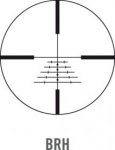BB,
I dont have a ton of experience holding over for shots, some, but not a lot, at least not at extended ranges. I've always thought, if you have the time to dial, that should be first option. Generally if you're shooting at an animal 400+ he's not aware of your presence you should have plenty of time to get your wind call correct, drop, dial the turrets and shoot. I practice a lot, but I will admit, not a lot in the holdover department.
I've been coyote hunting a lot this Winter and for that I have realized holding over is the only way to go, unless you catch one sleeping and sneak up to him. Because of that, I will be looking to swap scopes out on my 22-250 and get more proficient at holding over in hunting situations. It may or may not carry over to my big game, I don't know.
Your Swaro is a SFP scope. In my mind, at least, I'd feel that on a gun that I'll be doing quick holdovers with, I'd want a FFP. What are your thoughts on that? You ever hindered by having to be on a certain power for your scope to subtend correctly?
Once Spring hits I do intend to do more practice holding over. I'll be just using regular mil and moa has reticles though, which serve the same purpose.
Whisky,
Great post.
Those are exactly the issues I worried about before trying holdover reticle scopes. For years I made corrections with turrets on Leupy Mark 4s. It worked just fine, but I forgot to spin the turret back to zero more than once while moving quickly to get eyes on the critter after the shot.
Thanks for bringing up the SFP issue with the Swaros. As I am sure you are aware both FFP designs and SFP designs have advantages and disadvantages. SFP scopes have the advantage maintaining reticle thickness for shooting in low light at low powers. FFP designs, of course, have the advantage of being properly subtended at all magnifications.
I have never once had trouble getting my reticle properly subtended, because both of my holdover scopes are subtended at maximum magnification. I just turn them all the way up, which I would be doing anyway for shooting at ranges that require holdover.
I had a Zeiss Rapid Z scope that was properly subtended at an odd magnifcation (on my 3-9X40 it was 7.48 with one load) based on my load data, and it worked OK, but it is much easier in the field to just spin the magnification all the way up, as I do with the BRH.
The BRH would be a good option for you, if you are currently using a mil hash scope, as the reticle is subtended in 1/2 mil increments, rather than odd "BDC" increments. It also has the advantage of windage bars, which are actually more usefull in the field than I thought they would be.
For hunting, I like to keep my max magnification in my SFP reticle scopes between 9 and 16, so that they can perform suitably in all light conditions at max power, where the reticle is properly subtended.
If I went with a FFP scope, I would prefer it to be illuminated so the reticle would be easily visible at low powers in low light.
Give one a try whisky, they are pretty easy to get used to.

